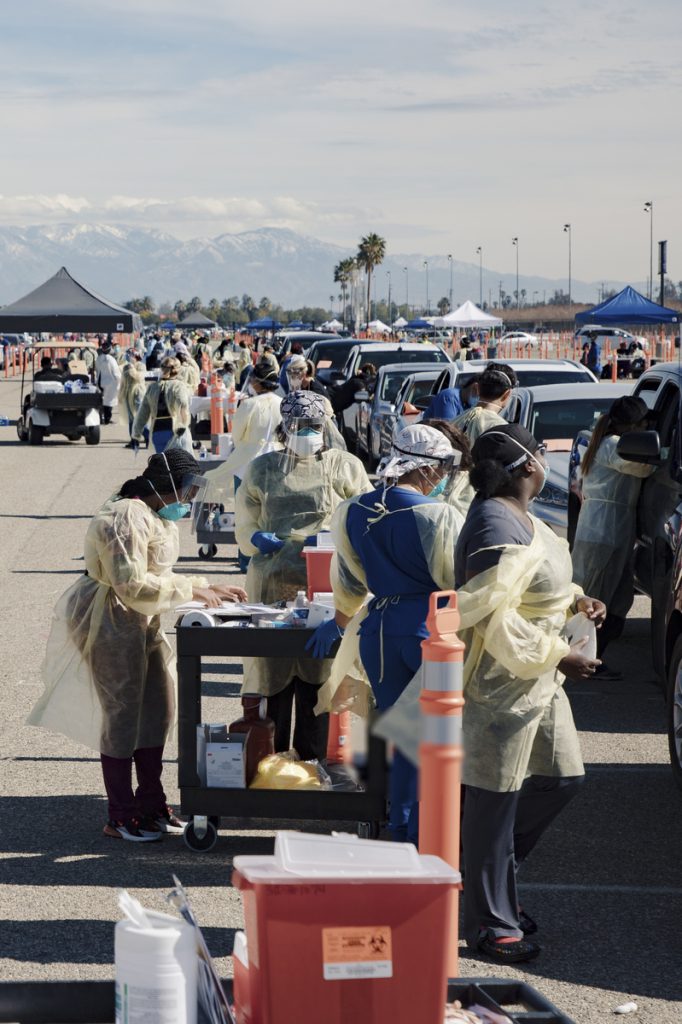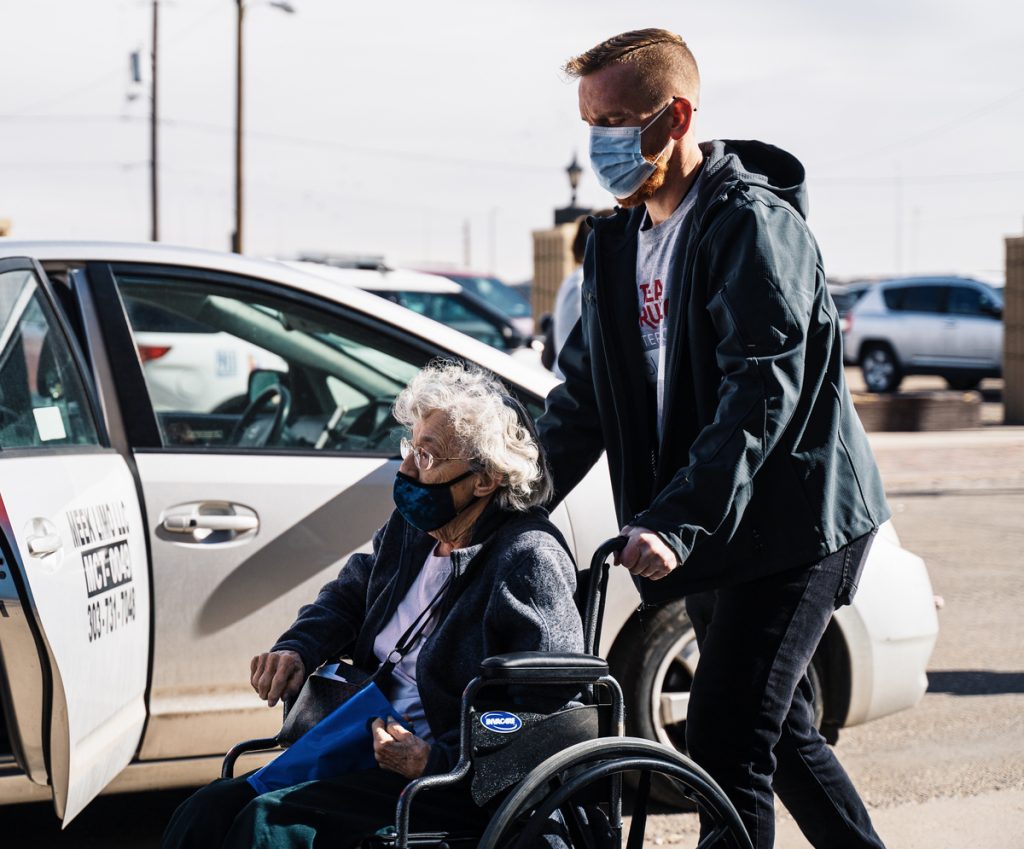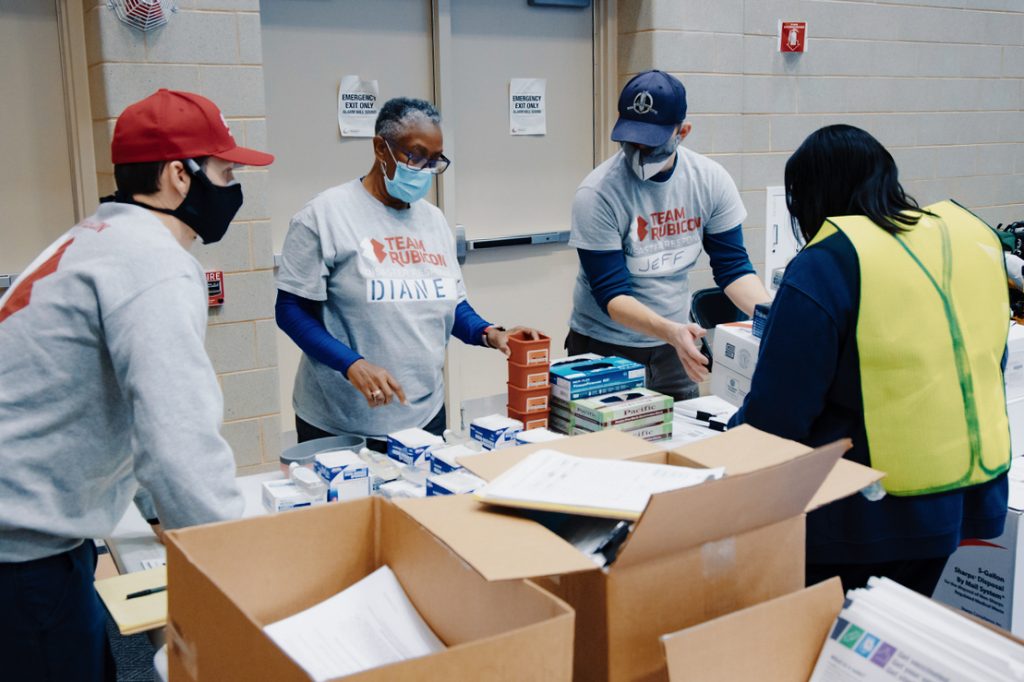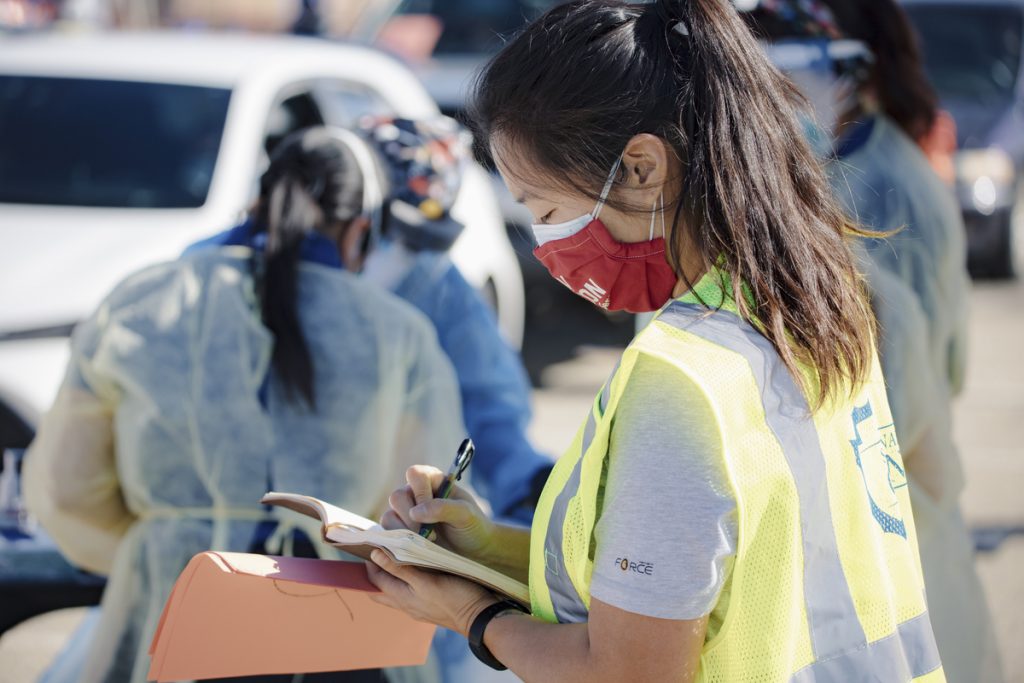What to Expect When Volunteering at a Vaccination Clinic
Ever wonder what really happens at a COVID-19 vaccination clinic? Team Rubicon Greyshirts tell all.
When the United States’ vaccination campaign began in late 2020, it was obvious finding a way to get millions vaccinated quickly wouldn’t be easy. Nor should the responsibility for getting all of America vaccinated fall squarely on the shoulders of the frontline workers who have shepherded the country through the pandemic. So, in December, volunteer organizations like Team Rubicon began stepping into the arena. Today, the veteran-led disaster relief organization has stood up, staffed, managed logistics for, and helped run vaccine sites in nearly 30 cities across the U.S. In some places, Team Rubicon volunteers—or Greyshirts—are responsible for traffic flow. In others, they make sure everything is in place to keep the vaccinations flowing. Every site, however, has one thing in common: it’s volunteer labor that’s making it possible to get shots in arms.
For those volunteers, knowing the scenario before hitting the ground helps make things run smoother. Here, veteran volunteers give a lay of the land and ideas about what to expect—whether you’re volunteering at a vaccination site or getting your first shot.
All Vaccination Clinics Are (Roughly) the Same
Regardless of whether it’s a drive-thru clinic or an in-person vaccination site, the layout will be fairly common: the first point of entry is typically a sort of gatekeeping station, where a volunteer will confirm the person hoping to be vaccinated has an appointment. Then, there will be a station for confirming registration, medical viability, and paperwork. After that, there’s the actual vaccination station, followed by an area where those just vaccinated will be monitored for reactions.
Can We Take Your Order? Understanding the Drive-Thru Vaccination Clinic
Some 3,200 vehicles are expected to snake through the COVID-19 vaccination lines at the Auto Club Speedway in Fontana, CA, this coming Tuesday. Some 100 Team Rubicon volunteers will be there to get all those people in all those cars through it.
“The cars are constantly moving,” says Team Rubicon volunteer Lorraine Riser. “It’s a very dynamic situation.”

After they’ve made it into the vaccination queue, that is. The first stop at most drive-thru vaccination is a gatekeeper station, where a volunteer will confirm someone in the vehicle has an appointment. From there, other vaccination volunteers will provide traffic control, directing drivers into the appropriate lane. In some locations, for example, a lane may be reserved for people who have experienced reactions to medication in the past. Or, the volunteer may be counting heads and directing traffic accordingly: The longest line may move the fastest if there’s only one person in each car, versus entire families to vaccinate.
The first stop in each lane is typically a registration stop, where medical personnel confirm eligibility, double-check medical history, and go through the appropriate paperwork.
Stop two is where the magic happens: Here, a nurse or medic will approach the car, open the vehicle door—or doors if multiple people are being vaccinated—and deliver the COVID-19 vaccine. They’ll also provide a vaccination record that includes the lot number of the dose given. Meanwhile, a volunteer or nurse will write a release time—typically 15 minutes, but 30 for those who have had a reaction in the past—on the car’s windshield. The vehicle will then move to an observation area or parking lot. Here, volunteers will monitor drivers and passengers for reactions or signs of distress before sending them on their way.
In-Person Vaccination Sites Have Traffic Control, Too
Even at in-person vaccination sites, volunteers are often responsible for traffic control—and wheelchair assistance.
That’s the case that SCL Health’s mass vaccination site at the National Western Complex in Denver, CO Denver vaccination which Team Rubicon Greyshirt have helped run.
In Denver, Greyshirts are typically tasked with helping people get into the parking lots, segregating cars into specific lots based on the mobility of the passengers, controlling pedestrian access as some lots are a distance from the actual vaccination area, managing the flow of traffic in and out, and assisting people being dropped off into wheelchairs before the shot, and out of wheelchairs and back into a car after their 15-minute-observation period is over.

Given the situation, there can be a fair amount of underlying emotional tension at such events. Finding ways to bring levity to the lines and process has been key to success in Denver, claims Greyshirt Skip Guarini.
“People are nervous. You know they’re anxious, and they want to make sure they get their shot,” says Guarini. “Our Greyshirts can sense when somebody’s feeling a little bit anxious or nervous and we lighten the mood. We tell jokes, and we get them laughing and smiling and, you know, we get them in and get them out and get them home.”
Out of the Parking Lot and Into the Supply Closet
While in most places Team Rubicon is providing wraparound support for vaccination sites, in places like Chicago, they are overseeing supplies and logistics.
Daniel Wilsea, a licensed professional counselor by training and a Greyshirt who has been volunteering at the Malcolm X College vaccine point of distribution (POD) in Chicago, says that here early preparation goes a long way.
While the Malcolm X POD runs from noon to 6 p.m., Greyshirts arrive at 10 a.m. to set up. After booting up computers and getting paperwork in order, volunteers prep the clinical table, making sure it’s supplied with all of the sharps’ containers and gloves nurses and doctors from the Chicago Health Department will need to draw and mix the vaccine. From there, the Greyshirts set up and stock each of the vaccination tables.

“At Malcolm X, we realized it makes the morning go smoother if we preset the vaccines kit,” explained Wilsea. That means stocking each vaccination table with a box of 130 bandaids, a box of 200 alcohol prep pads, two-by-two gauze, a kidney basin, hand sanitizer, a small biohazard bag, trash bags, and the sharps container.
“Just setting that on the vaccination tables for the nurses and the clinical staff before they get here in the morning saves so much time. Then, the only thing that the nursing staff has to do is come get gloves and they’re up and running for the day,” says Wilsea.
Once the clinic opens, the Greyshirts float between the supply closet and vaccination tables, ensuring everyone has the supplies they need. Sometimes, they’ll step in to help with line flow; occasionally, they’ll even assist in the observation area.
No matter whether you’re volunteering at a massive drive-thru vaccination site, as with the Auto Club Speedway site in Fontana or at an in-person daily POD in Chicago, flexibility is key. As much as vaccination sites need nurses and doctors to deliver injections, they need even more people to monitor for reactions, direct traffic, and keep syringes flowing. Vaccination volunteers should expect to do everything but put shots in arms. Come prepared to run forms from one station to another, direct multiple lanes of traffic, or refill the supply closet. And those may be the most essential roles. After all, it would be a waste of precious resources to pull a nurse off the frontlines and put her in traffic control.
“No day is like another,” says Wilsea. “One day you might find yourself spending a lot of time in the supply closet getting all the stock counts around. Another, you’re at the clinical table unwrapping a lot of syringes for the nurses. It’s all about that flexibility.”
Tips from the Volunteer Vaccination Pros
Want to ensure a great day on a vaccination deployment? Here’s what to bring, and know.
Dress for Vaccination Success
Whether a volunteer is stocking the supply room or running traffic control, they’re likely to be on their feet all day long. As such, comfortable shoes are critical to success.
So are layers.
“Another thing that we have to deal with here is the weather,” says Denver’s SKIP. When volunteers are outside at a vaccination site all day it’s not uncommon to have a temperature shift across the day. In San Bernardino, that means a hot day turns cold when the sun goes down and volunteers go from shirtsleeves to jackets. In Denver, the situation may be reversed. “We might start the day in a foot of snow and 18 degrees. By this afternoon, we’ll be in full melt bright sunshine and it’ll be 45.” All of which means vaccination volunteers should pack everything from sun protection to winter layers.
Keep a Cheat Sheet
Have extra info at your fingertips based on the area you’re manning. For gatekeepers responsible for turning away people without an appointment, being able to provide a phone number to register for the vaccine can go a long way.
Change Your Socks. And Your Mask.
“While we’re out there are, it’s definitely a marathon, not a race,” explained Riser. “The hours are very long for us because we accept the 12-hour shift.” So, Riser recommends packing a go-bag full of anything a volunteer might need to be self-sufficient for a 12-hour-stretch. “Any medication that they might take during the day any, things that things that will provide them their comfort level while they’re out there—maybe a change of socks, candy or gum, and a change of tennis shoes or boots.”
In cold-weather climes such as Jefferson, WI, that also means bringing a spare mask. Work outside all day in single-degree temperatures and within hours, that mask will be soaked. Having a dry mask to switch into during the day will mean the difference between comfort and chinsicles.
